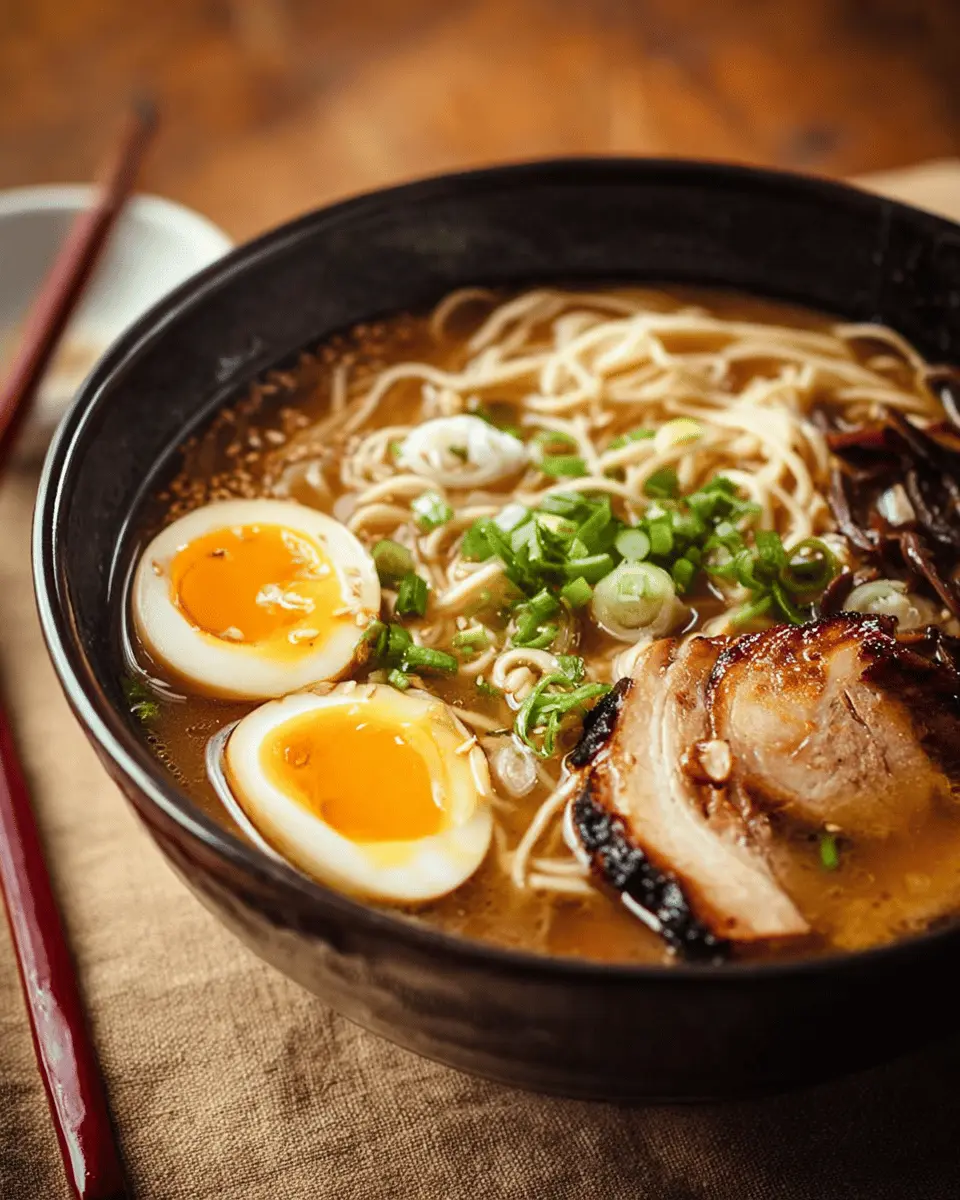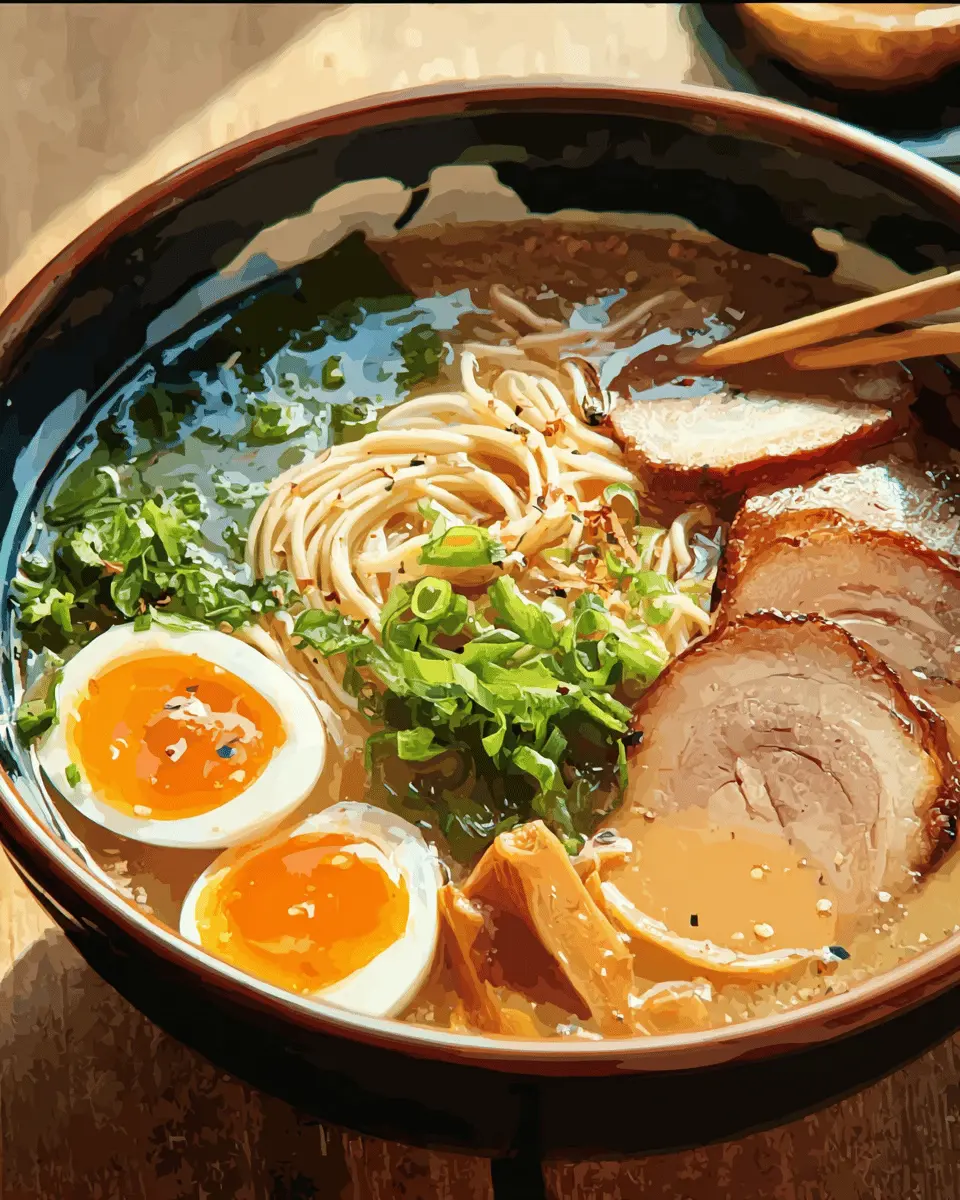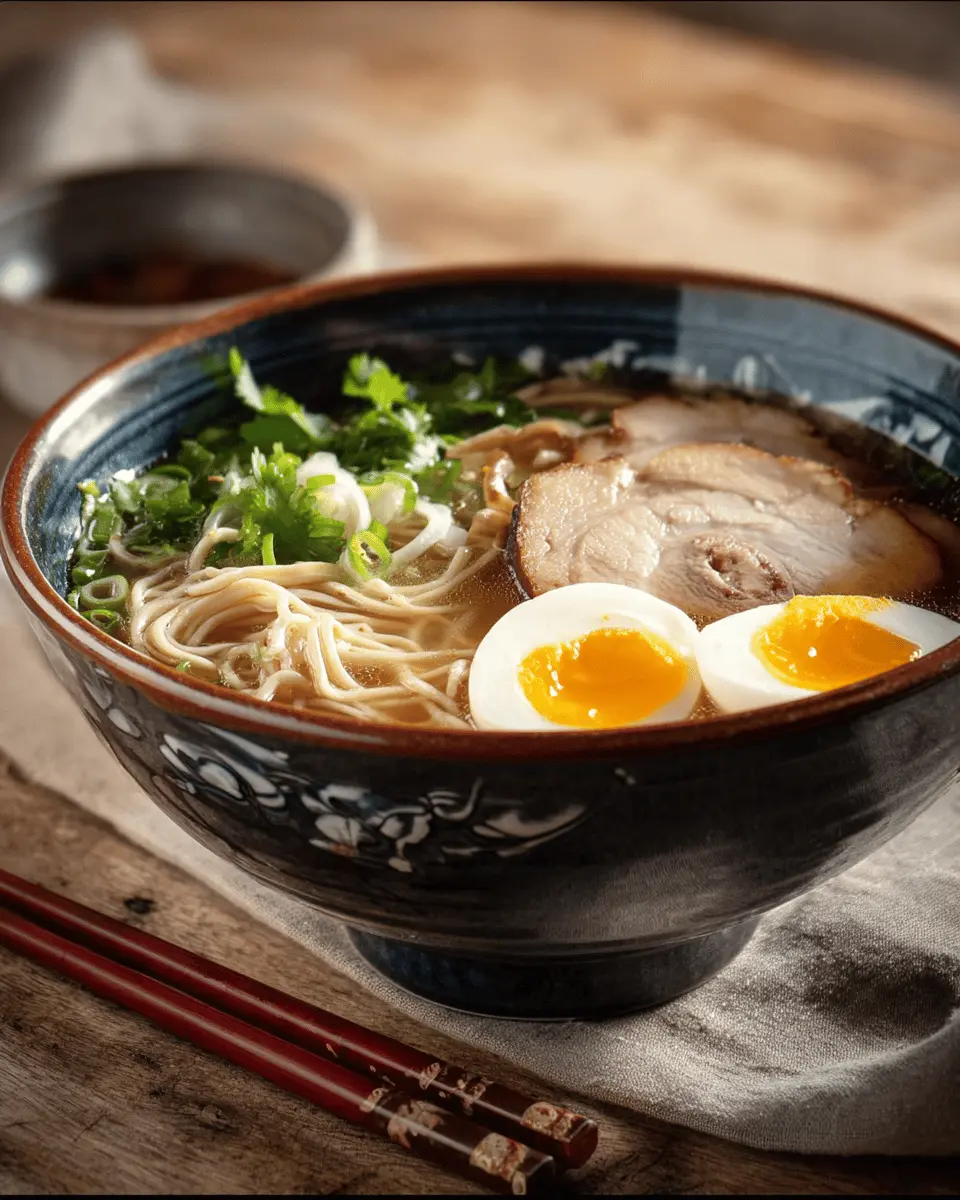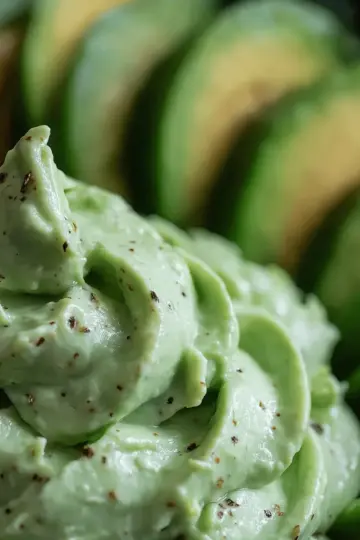Introduction to Tonkotsu Ramen at Home
Why homemade tonkotsu ramen is a game-changer
If you're looking to elevate your home cooking game, making tonkotsu ramen at home is an absolute must. This iconic Japanese noodle soup delivers rich flavors that can rival your favorite ramen shop. The secret? A creamy, deeply flavored pork broth, perfectly cooked ramen noodles, and tender chashu beef—a combination that creates pure comfort in a bowl.
Why settle for store-bought when you can craft a version tailored to your taste? You can customize ingredients, control the saltiness, or even tweak the broth to suit your dietary preferences. Plus, the satisfaction of crafting your own delicious meal is unparalleled.
Tonkotsu ramen’s preparation may seem daunting, requiring hours to develop that luscious broth, but most of the time is hands-off. As the broth simmers, you can focus on getting the rest of the components ready, like the perfectly medium-boiled eggs or the savory tare.
For those curious about the intricate process, Food & Wine offers fantastic insights into noodle soup techniques. So don your apron and prepare for a culinary adventure; you’ll soon discover why making tonkotsu ramen at home is not just a trend—it's a delightful experience.

Ingredients for Tonkotsu Ramen
To whip up a delightful bowl of tonkotsu ramen at home, gathering the right ingredients is crucial! Here’s a breakdown to help make your ramen experience unforgettable.
Essential ingredients for the broth
- 8 cups tonkotsu beef broth: The soul of your ramen, rich and flavorful.
- 12 oz dried ramen noodles: Choose a good-quality brand for authentic texture.
Ingredients for chashu beef
- 2 lb beef belly (rolled and tied): This gives you that melt-in-your-mouth goodness.
- ¼ cup soy sauce: For a savory depth.
- ½ cup sake substitute: Opt for a non-alcoholic mirin or even rice vinegar.
- ½ cup mirin
- ¼ cup sugar: Balance that savory with a hint of sweetness.
- 2-3 cloves garlic: Whole, to infuse flavor.
- 2 green onions: Coarsely chopped for extra taste.
Components for soy turkey bacon tare and miso tare
- Soy turkey bacon: Two slices, giving a smoky touch and crunch.
- ¼ cup soy sauce
- ¼ cup shiro miso: For richness.
- Sake substitute (for miso tare) and a pinch of shichimi togarashi (optional), enriching your ramen.
Additional toppings and garnishes
- Soft-boiled eggs: Medium-boiled to add indulgence.
- Mushrooms: 2-3 oz enoki or any variety you enjoy.
- Sliced green onions: Fresh for that final touch.
With these carefully selected ingredients, you can feel confident creating the perfect bowl of tonkotsu ramen at home. For more inspiration, check out some classic broth methods here.
Preparing Tonkotsu Ramen
Creating tonkotsu ramen at home is an amazing culinary journey, blending rich flavors and textures to deliver a bowl of pure comfort. In this section, we’ll dive into the steps to prepare this masterpiece, ensuring each component complements the next.
Prepare the Chashu Beef
Starting with the star of the show, the chashu beef, is key to achieving that mouthwatering flavor. Here’s how:
-
Ingredients:
-
2 lb beef belly, rolled and tied
-
¼ cup soy sauce
-
½ cup mirin (use a non-alcoholic substitute if preferred)
-
¼ cup sugar
-
2-3 cloves of garlic, whole
-
2 green onions, coarsely chopped
-
Instructions:
- Combine the soy sauce, mirin, sugar, garlic, and green onions in a resealable bag designed for marinating.
- Remove the air from the bag using a straw method to ensure your flavors really get infused.
- Set your sous vide to 170°F and cook for 10-11 hours. If you don’t own a sous vide, consider braising it on the stove or in the oven until tender (approximately 3-4 hours).
- Once cooked, let the meat cool and slice it thinly across the grain. Reserve this for assembly later!
Make the Soy Turkey Bacon Tare
The tare is what brings additional depth to your tonkotsu ramen at home.
-
Ingredients:
-
2 slices of turkey bacon
-
¼ cup soy sauce
-
2 tablespoons of mirin
-
2 tablespoons of sake (or a non-alcoholic option)
-
4 tablespoons shiro miso
-
Instructions:
- In a small saucepan, mix all ingredients and simmer on low heat for about an hour, adding chicken stock if necessary to maintain volume.
- Once the flavors have melded, remove from heat and set aside.
Prepare the Miso Tare
This tare complements the rich broth beautifully.
-
Ingredients:
-
½ cup shiro miso
-
¼ cup sake or alternative
-
¼ cup mirin
-
Pinch of shichimi togarashi (if you fancy a kick)
-
1-2 teaspoons kosher salt
-
Instructions:
Simply combine all ingredients in a saucepan, simmer for about 5 minutes, and you're ready to go! Adjust salt levels according to taste.
Cook the Medium-Boiled Eggs
These eggs are a classic addition that balances the flavors of your ramen.
- Instructions:
- Bring a pot of water to boil and carefully add the eggs. For large eggs, boil for 6 minutes and 30 seconds, and for extra-large eggs, aim for 7 minutes and 30 seconds.
- Immediately transfer the eggs to an ice bath to stop the cooking process, then peel and halve just before serving.
Assemble the Ramen Bowl
Now for the fun part—putting everything together!
- Boil the ramen noodles according to package instructions, which usually takes about 4 minutes. Get those tender noodles just right!
- As the noodles cook, throw in your choice of enoki mushrooms to soften.
- Sear the chashu beef slices until they’re lightly browned to enhance flavor.
- In each serving bowl, add your prepared tare, pour in the tonkotsu broth (about ½ cup), and mix.
- Next, add the noodles, pour in another 1 ½ cups of broth, and top with half a medium-boiled egg, mushrooms, chashu, and green onions.
Sit down with a steaming bowl of your homemade tonkotsu ramen and enjoy this delicious labor of love! For more insights and tips on ramen, you might want to check out Serious Eats. Happy slurping!

Variations on Tonkotsu Ramen
Exploring tonkotsu ramen at home opens up a delightful world of variations that can cater to various tastes. Let's dive into a couple of options that can spice up your ramen experience!
Tonkotsu with Different Proteins
While traditional tonkotsu ramen features beef or chicken, don’t hesitate to mix things up! For a leaner touch, try turkey or even chicken ham as alternatives. You can also opt for seafood like shrimp or scallops to create a lighter broth that's perfect for warmer months. Each protein brings its unique flavor, complementing the rich broth beautifully.
Vegetarian Tonkotsu Ramen Options
Craving a delightful meatless meal? Vegetarian tonkotsu ramen is a breeze to create! Substitute your meats with hearty toppings like marinated tofu, roasted vegetables, or even mushrooms for that umami kick. Use vegetable broth instead of the classic pork base and enhance the flavor with soy sauce or shoyu. This way, everyone gets to enjoy the comforting essence of ramen!
For more inspiration, check out this guide on ramen toppings to explore endless possibilities. Happy ramen-making!
Cooking Tips for Perfect Tonkotsu Ramen
Consistency Tips for the Broth
To achieve that luxurious, creamy texture in your tonkotsu ramen at home, focus on simulating the gelatin-rich base commonly derived from simmering beef bones. Use a mix of bones and meat, and let it simmer for a long time, ideally around 12 hours. This slow cooking extracts collagen, giving your broth a silky mouthfeel. Remember to skim the fat throughout cooking, as it can clump up if left unattended.
Flavor Balancing Techniques
When building flavor, think about balance. You can play with salty, sweet, and umami elements by adjusting the amounts in your tare. If it tastes too salty, add a bit of sugar; if it’s overly sweet, a dash of soy sauce can help. Taste as you go and remember, layering flavors is key for that authentic taste.
Saving Time with Meal Prep
Consider making your tonkotsu ramen ingredients in advance! Prepare the chashu pork belly or boil the eggs the night before. Not only does this save you time, but it also allows the flavors to meld wonderfully. You can batch-cook the broth and freeze it in portions, so delicious ramen is just a few minutes away on busy weeknights.
For more tips on making ramen, you can check out this guide from Serious Eats. Happy cooking!

Serving Suggestions for Tonkotsu Ramen
Ideal Accompaniments to Enhance Flavor
When crafting tonkotsu ramen at home, think beyond the bowl. A few thoughtful accompaniments can elevate the dish:
- Nori Sheets: Add a marine flair with toasted seaweed, perfect for wrapping bites of noodles.
- Miso Paste: Swirl in a dash of miso for a richer umami flavor.
- Chili Oil: For those who enjoy heat, a drizzle of chili oil can provide a lovely kick.
Creative Ways to Serve Ramen
Serving tonkotsu ramen can be an art in itself! Consider these fun ideas:
- Ramen Bar: Set up a DIY ramen bar with various toppings like soft-boiled eggs, fresh greens, and pickled vegetables. Let everyone customize their bowl!
- Bento-Style Presentation: Serve individual bowls of broth alongside small compartments filled with toppings, similar to a traditional Japanese bento box.
- Seasonal Twists: Experiment with seasonal vegetables, like roasted pumpkin in the fall or cherry tomatoes in summer, to add fresh flavors to your ramen.
For more inspiration on ramen toppings and techniques, check out culinary resources like Serious Eats or Japanese Cooking 101. Enjoy your flavorful bowl of comfort!
Time Breakdown for Tonkotsu Ramen
Preparation Time
Getting your ingredients ready is essential! You’ll spend about 30 minutes prepping everything you'll need for this delicious tonkotsu ramen at home. Think chopping those flavorful green onions and marinating the beef.
Cooking Time
Now, for the magic. The cooking time is 12 hours. Yes, it sounds like a long haul, but most of it is hands-off thanks to techniques like sous vide. This low-and-slow method really lets those flavors develop beautifully.
Total Time
In total, you’re looking at 12 hours and 30 minutes from start to finish. Trust us, the delicious aroma wafting through your home will make every second worth it. Ready to enjoy a delightful bowl of rich, savory ramen? We thought so!
For more tips on creating homemade tonkotsu broth, check out this detailed guide on making tonkotsu ramen broth.
And remember, cooking is all about patience and passion! Enjoy the journey as you dive into the flavorful world of ramen.
Nutritional Facts for Tonkotsu Ramen
When crafting tonkotsu ramen at home, it's essential to understand its nutritional profile. Here’s a breakdown of what you can expect per serving:
Calories per serving
Enjoying a comforting bowl of tonkotsu ramen comes with about 1262 calories. This hearty meal is perfect for a cozy night in or a gathering with friends.
Protein content
Each serving provides approximately 33 grams of protein, thanks to the delicious beef chashu and eggs. This makes it a great option for those looking to fuel up after a long day.
Sodium levels
One thing to note is the sodium content—each bowl contains around 2803 mg of sodium. While it adds to the rich flavors, you may want to keep this in mind if you’re watching your sodium intake.
For further details on ramen nutrition, you can explore resources from the USDA and other nutrition databases. Keep these facts in mind to enjoy your delicious homemade tonkotsu ramen responsibly!
FAQs about Tonkotsu Ramen
How can I customize my tonkotsu ramen?
Personalizing your tonkotsu ramen at home is part of the fun! You can add:
- Protein Options: Swap chashu pork for beef or even chicken to suit your taste.
- Toppings: Consider adding corn, bamboo shoots, or seaweed for extra flavor and texture.
- Spice Level: Want a kick? Toss in some chili oil or add shichimi togarashi for a spicy twist.
Feel free to experiment and find your perfect bowl!
What are the best storage practices for leftovers?
If you have leftovers, store them separately to maintain texture. Cool the broth and pour into an airtight container, while noodles should be kept in another. They can last up to 3 days in the refrigerator. When reheating, add a splash of water to the broth, and cook the noodles just until heated through.
Can I substitute any ingredients for dietary restrictions?
Absolutely! For a gluten-free option, seek out gluten-free ramen noodles. You can easily replace ingredients such as beef with chicken or use plant-based proteins for a vegetarian version. Check out sources like The Vegetarian Resource Group for more dietary alternatives. Cooking tonkotsu ramen at home allows you to get creative while catering to your needs!
Conclusion on Tonkotsu Ramen at Home
Creating tonkotsu ramen at home is a rewarding journey that offers rich flavors and comforting warmth. With a little patience for the broth and a few simple ingredients, you can enjoy a delicious bowl of ramen right in your kitchen. Dive into this culinary adventure, and share it with friends and family!

tonkotsu ramen at home
Equipment
- sous vide machine
- saucepan
- non-stick skillet
- ziploc bag
- strainer
Ingredients
Tonkotsu ramen
- 8 cups tonkotsu pork broth recipe link below
- 12 oz good quality dried ramen noodles
- 4 large or extra large eggs
- 2-3 oz enoki or other mushrooms
- thinly sliced green onions
Chashu pork belly
- 2 lb pork belly rolled and tied
- ¼ cup soy sauce
- ½ cup sake
- ½ cup mirin sweet Japanese wine
- ¼ cup sugar
- 2-3 cloves garlic left whole
- 2 green onions coarsely chopped
Soy bacon tare
- 2 slices bacon use good quality bacon here
- ¼ cup soy sauce
- 2 tablespoon mirin
- 2 tablespoon sake
- 4 tablespoon shiro miso
Miso Tare
- ½ cup shiro miso
- ¼ cup sake
- ¼ cup mirin
- pinch shichimi togarashi optional
- 1-2 teaspoon kosher salt depending on how salty you like your ramen
Instructions
Chashu pork belly
- Combine the soy, sake, mirin, sugar, garlic and green onions in a ziploc bag large enough to hold the pork belly. Stick a straw in the bag and seal the ziploc bag up against it (so the straw is the only opening). Suck as much of the air out as you can and seal.
- Sous vide the pork for 10-11 hours at 170F.
- Remove pork from the ziploc bag. Discard the bag and marinade.
- Let the chashu pork belly cool completely.
- Slice across the chashu pork into 8-12 slices about ⅛ to 3/16 inches thick. Reserve.
Soy bacon tare
- Combine all the ingredients in a small sauce pan. Simmer at the lowest setting for about an hour. Top up with a bit of chicken stock if needed.
- Remove the bacon.
Miso tare
- Combine all ingredients in a small sauce pan and simmer at the lowest setting for about 5 minutes.
Medium boiled eggs
- Bring enough water to cover the eggs to a boil. If you have a way to prick the eggshell do it. Boil large eggs for 6 minutes 30 seconds. If using extra large eggs boil them for 7 minutes 30 seconds. Adjust your times slightly depending on the exact size of your eggs.
- Submerge the eggs in cold or ice water to chill. Peel. Cut in half right before you serve your tonkotsu ramen.
Assemble the tonkotsu ramen
- Boil the ramen noodles in plenty of water as directed by the packaging, usually about 4 minutes. You don't need to salt the water.
- Cook the mushrooms alongside the noodles until softened.
- Gently fry the chashu pork in a non-stick skillet until lightly browned.
- Place ¼ of whichever tare you are using in the bottom of four bowls.
- Ladle in about ½ cup of the tonkotsu broth into each of the bowls and stir to mix.
- Add the noodles. Pour in another 1 ½ cups of the tonkotsu broth per bowl.
- Top with the egg, mushrooms, pork and green onions.





Leave a Reply